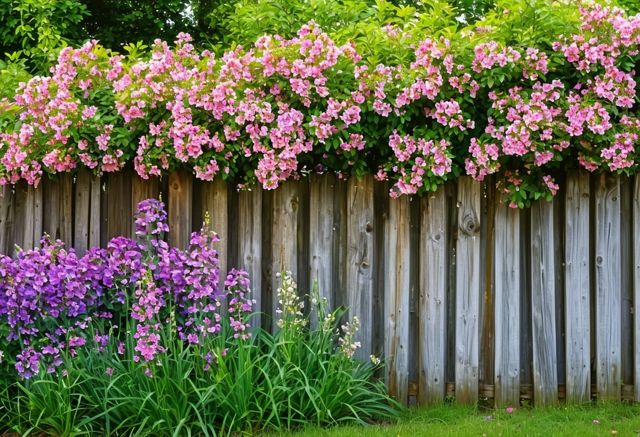The cost of fence installation is influenced by material and style choices, contractor rates and experience, land conditions, permits and regulations, and seasonal considerations. Factors such as the type of wood, design complexity, contractor expertise, land topography, permit fees, and seasonal demand all play significant roles.
1. Fence Material and Style Choices
Different materials and styles influence the cost of fencing. Wood, for example, is generally more affordable but needs more maintenance than metal or vinyl. Cedar and pine are common wood choices, with cedar being pricier but more durable.
- Wood Types: Cedar is more expensive but lasts longer, while pine costs less but may need more upkeep.
- Cost Estimates: Wood fences usually range from $3 to $7 per linear foot.
The design of your fence also plays a role in the overall cost. Simple designs like picket fences are less costly compared to intricate lattice or privacy fences.
- Style Types: Picket, lattice, and privacy designs
- Impact: Simpler designs cost less; more complex designs are pricier.
When planning your fence, consider how the wood type and design will impact both the initial cost and long-term maintenance. This way, you can choose a fence that fits your budget while meeting your functional and aesthetic needs.

2. Contractor Rates and Experience
The rates and experience of the contractor you choose can greatly impact the overall cost of fence installation. Experienced contractors often charge higher rates, but their expertise can potentially save you money in the long run through efficient work and fewer mistakes. Here are some factors to consider:
- Skill Level and Quality of Work: Experienced contractors generally produce higher-quality work, which can reduce future repair costs.
- Local Rates: Compare rates from multiple contractors in your area to ensure you’re getting a fair price. Rates can vary significantly between contractors.
- Specializations: Contractors specializing in certain types of fencing might charge more but offer better craftsmanship.
- Reputation and Reviews: Contractors with positive reviews and a strong reputation might charge higher rates. However, their reliable service can be worth the extra cost.
- Licenses and Insurance: Licensed and insured contractors might come at a higher price, but they offer added security and professionalism.
Understanding these factors can help you make an informed decision and balance cost with quality.
3. Topography and Land Conditions
The shape and condition of your land, including slopes and soil type, can affect installation difficulty and cost. Discover why flat, clear land might be cheaper to fence than a hilly or rocky area.
Flat and clear land is easier and cheaper to fence. Here’s why:
- Fewer Adjustments: Flat terrain requires minimal adjustments, reducing labor costs.
- Simple Equipment: Standard tools can be used without needing specialized equipment.
- Efficient Work: Workers can complete fencing faster on flat land.
When dealing with hilly or rocky areas, costs rise due to:
- Extra Labor: Steep slopes or uneven terrain demand more effort and time.
- Specialized Tools: Rocky ground may require specialized drills and anchors.
- Added Materials: Reinforcements might be needed to ensure fence stability.
Understanding the land’s topography helps in planning and budgeting for a fence installation. Whether you have a garden or a large property, the condition of the land will influence overall expenses.

4. Permits and Regulations
Local building codes and permits can significantly impact the cost of fence installation. Fees must often be paid to obtain necessary permits, and these can vary depending on the jurisdiction. It’s essential to understand these regulations to avoid unexpected expenses.
Some key considerations include:
- Permit Fees: These can range from a small amount for basic residential projects to higher fees for more complex or expansive installations.
- Inspection Costs: Some areas require inspections before and after installation, which may involve additional fees.
- Zoning Rules: Ensure your fence complies with local zoning laws, which dictate allowable height, materials, and placement.
- Historical Districts: Special regulations might apply in historic neighborhoods, potentially adding to your costs and requiring specific materials or designs.
- HOA Guidelines: If you live in a community with a homeowners association, they may have specific requirements and fees for fence installations.
Understanding these factors can help you budget more accurately and avoid delays or legal issues during your fence project.

5. Seasonal Considerations
The time of year can significantly impact installation costs due to changes in demand and weather conditions. Here are a few factors to consider when scheduling your fencing project:
- Demand Fluctuations: Spring and summer are popular times for fence installations, leading to higher demand and possibly increased costs. Scheduling during the off-peak seasons, such as fall and winter, could lead to better pricing.
- Weather Conditions: Weather plays a crucial role. Mild weather allows for easier digging and cement setting. Harsh weather conditions can slow down work and potentially increase costs.
Planning your fence installation during less busy seasons can help you potentially save both time and money, while also ensuring that weather conditions are favorable for a smooth installation process.

FAQ
How does the choice of fence material and style affect installation cost?
Different materials and styles influence the cost of fencing. Wood is generally more affordable but requires more maintenance compared to metal or vinyl. Cedar, being more durable, is more expensive than pine. Simple designs like picket fences are less costly, whereas intricate lattice or privacy fences are pricier. The choice of material and design will impact both the initial cost and long-term maintenance.
What are the cost ranges for different types of wood fences?
Wood fences typically range from $3 to $7 per linear foot, depending on the type of wood and the complexity of the design. Cedar is more expensive but longer-lasting, while pine is cheaper but may require more upkeep over time.
How do contractor rates and experience affect the cost of fence installation?
Experienced contractors often charge higher rates due to their expertise, which can result in higher quality work and potentially lower future repair costs. Comparing rates from multiple contractors in your area can help ensure you’re getting a fair price. Specialized, licensed, and insured contractors might charge more but offer added security and professionalism.
How does the land’s topography influence fence installation costs?
Flat and clear land is easier and cheaper to fence because it requires minimal adjustments, standard tools, and allows for faster work. Hilly or rocky areas increase costs due to extra labor, specialized tools, and additional materials needed for reinforcing the fence to ensure stability.
What role do permits and local regulations play in fence installation costs?
Local building codes and permits can significantly impact the cost. Permit fees, inspection costs, zoning rules, and specific requirements in historic districts or homeowner association guidelines can add to your costs. It’s essential to understand these regulations to avoid unexpected expenses and legal issues.
How do seasonal considerations affect fence installation costs?
The time of year can significantly impact installation costs. Spring and summer are peak seasons for fence installations, leading to higher demand and increased costs. Scheduling during off-peak seasons like fall and winter could lead to better pricing. Additionally, mild weather conditions facilitate easier installation, whereas harsh conditions can slow down work and potentially increase costs.

